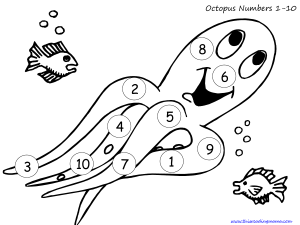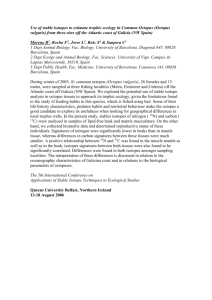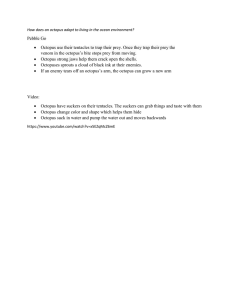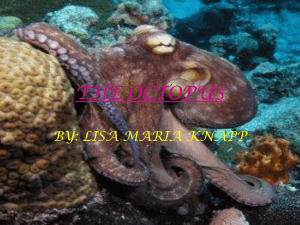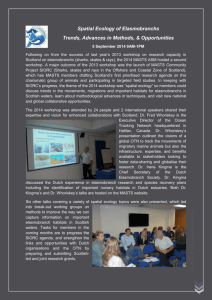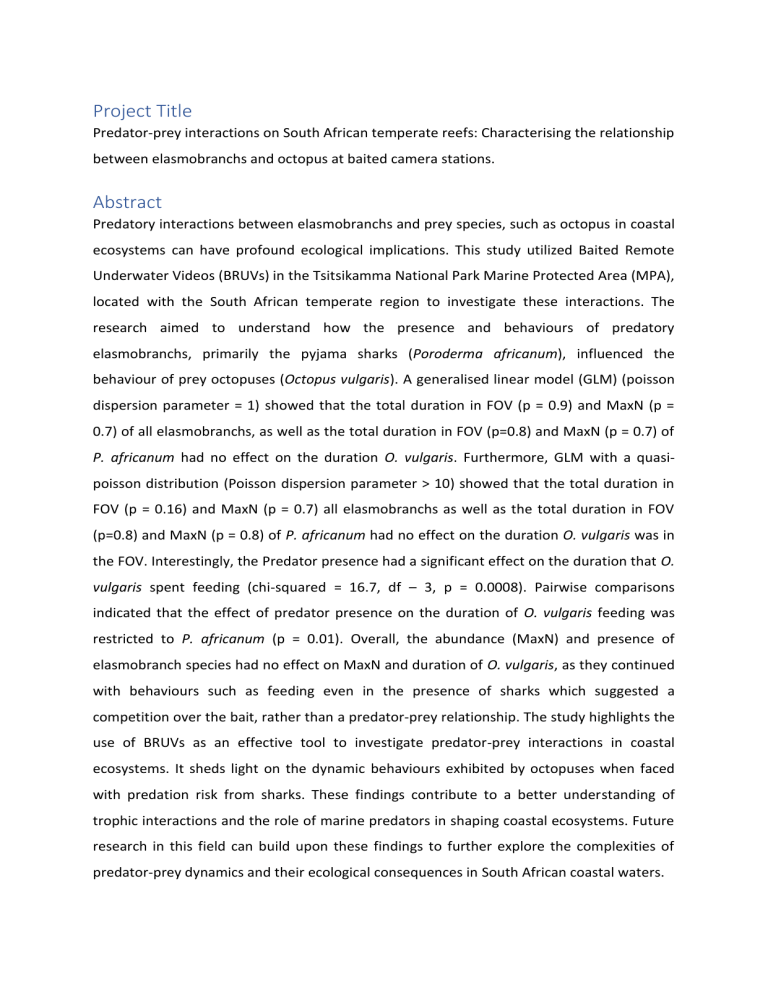
Project Title Predator-prey interactions on South African temperate reefs: Characterising the relationship between elasmobranchs and octopus at baited camera stations. Abstract Predatory interactions between elasmobranchs and prey species, such as octopus in coastal ecosystems can have profound ecological implications. This study utilized Baited Remote Underwater Videos (BRUVs) in the Tsitsikamma National Park Marine Protected Area (MPA), located with the South African temperate region to investigate these interactions. The research aimed to understand how the presence and behaviours of predatory elasmobranchs, primarily the pyjama sharks (Poroderma africanum), influenced the behaviour of prey octopuses (Octopus vulgaris). A generalised linear model (GLM) (poisson dispersion parameter = 1) showed that the total duration in FOV (p = 0.9) and MaxN (p = 0.7) of all elasmobranchs, as well as the total duration in FOV (p=0.8) and MaxN (p = 0.7) of P. africanum had no effect on the duration O. vulgaris. Furthermore, GLM with a quasipoisson distribution (Poisson dispersion parameter > 10) showed that the total duration in FOV (p = 0.16) and MaxN (p = 0.7) all elasmobranchs as well as the total duration in FOV (p=0.8) and MaxN (p = 0.8) of P. africanum had no effect on the duration O. vulgaris was in the FOV. Interestingly, the Predator presence had a significant effect on the duration that O. vulgaris spent feeding (chi-squared = 16.7, df – 3, p = 0.0008). Pairwise comparisons indicated that the effect of predator presence on the duration of O. vulgaris feeding was restricted to P. africanum (p = 0.01). Overall, the abundance (MaxN) and presence of elasmobranch species had no effect on MaxN and duration of O. vulgaris, as they continued with behaviours such as feeding even in the presence of sharks which suggested a competition over the bait, rather than a predator-prey relationship. The study highlights the use of BRUVs as an effective tool to investigate predator-prey interactions in coastal ecosystems. It sheds light on the dynamic behaviours exhibited by octopuses when faced with predation risk from sharks. These findings contribute to a better understanding of trophic interactions and the role of marine predators in shaping coastal ecosystems. Future research in this field can build upon these findings to further explore the complexities of predator-prey dynamics and their ecological consequences in South African coastal waters. Introduction Marine predators can play important roles in coastal ecosystems by exerting top–down effects on prey through consumptive and non-consumptive interactions, i.e., predation and fear-based effects. The exact nature of these roles varies based on several factors, including how predator and prey directly interact. Studying predator-prey interactions and behaviours can help in understanding and identifying crucial trophic linkages and the implications of top-down effects of predation on aspects such as population dynamics and food webs (Hunsicker et al. 2011, Sherman et al. 2020). Unfortunately, insights into predator-prey interactions remain limited because of the difficulty of observing these interactions in the wild. Baited Remote Underwater Videos (BRUVs) provide a unique opportunity to witness and study predator-prey interactions (Harvey et al. 2013). In particular, BRUVs collected on temperate reefs along the coast of South Africa have noted interactions between the common octopus (Octopus vulgaris) and predatory elasmobranchs such as pyjama sharks Poroderma africanum, short-tail stingrays (Bathytoshia brevicaudata), common smoothhound sharks (Mustelus mustelus), common eagle rays (Myliobatis aquila), leopard catsharks (Poroderma pantherinum), Puffadder shysharks (Haploblepharus edwardsii), and dark shysharks (Haploblepharus pictus). Predation has been considered to have a significant influence on the behaviour patterns of prey, as well as on other aspects such as abundance and movements (Sherman et al. 2020). The impacts of predation on preys can be exerted through consumptive or fear-based interactions (Sherman et al. 2020, Mitchell & Harborne 2020, Shea et al. 2020). An example of a consumptive interaction is when the predator attacks and kills its prey for consumption (Mitchell &Harborne 2020). On the other hand, fear-based effects can lead to a change in habitat occupancy and the foraging ability of prey, which can ultimately slow the individual growth and increase the prey's vulnerability to predation (Bax 1998, Sherman et al. 2020). The influence of marine predators on prey behaviour has been observed across multiple taxa and habitats (Bax 1998). For example, a study by Sherman et al. (2020) on the effects of predator removal on rays in coral reef ecosystems revealed that rays were more likely to appear when their predators, sharks, were not present. Furthermore, the behavioural impact of the absence of predators was that rays spent more time in the video frame and fed on bait (Sherman et al. 2020). A similar phenomenon of antipredator behaviour was observed in an Australian mangrove-lined bay where juvenile rays avoided being detected by predators by hiding in mangroves during high tide, and during low tide they hid by submerging their bodies in shallow waters (Davy et al. 2015). BRUVs also revealed that the feeding attempts of smooth dogfish (Mustelus canis) on bait off Cape Cod, Massachusetts, were reduced in areas where white sharks (Carcharodom carcharias), one of their predators, were abundant (Shea et al. 2013). Apart from avoidance behaviour, prey can exhibit defence mechanisms when they are attacked by their predators (Schmitt & Strand 1982). An instance of defence was observed in the behaviour of the common Pacific coral reef octopus (Octopus cyanea) which was studied using underwater videos, where the octopus was attacked by a small moray eel of about 0.5 metres in length (Forsythe & Hanlon 1997). The octopus responded by violently pulling away its arms, changing its body pattern, and excreting an ink substance in form of black clouds, consequently causing the eel to fail to detect the octopus due to the ink which interrupted its sight (Forsythe & Hanlon 1997). This instance reveals that a prey is capable of escaping from their predators even if they are at high risk of being killed by using their adaptations such as visual senses, body posture and chemical cues (Mitchell & Harborne 2020). In some instances, prey can move in groups to defend themselves against predators (Schmitt & Strand 1982), and predators also tend to respond by approaching the schooling prey in a group (Motta & Huber 2012). Predatory elasmobranchs, which are known for mostly solitary foraging, can also perform group foraging, such as the seven-gill sharks that can attack their prey by forming a circle around them to prevent them from escaping (Motta & Huber 2012). Another similar observational study was based on Santa Catalina Island, where seven yellowtail fish (Seriola lalandei) attacked a large school of more than 2000 jack mackerels (Trachurus symmetricus) in open waters splitting a smaller group from the main group and chased the small group (Schmitt & Strand 1982). While there are several studies investigating predator-prey interactions globally, there are very limited examples from South African coastal waters. One such study investigated the interaction between predatory elasmobranchs and chokka squid (Loligo vulgaris reynaudii) using underwater video recordings (Smale et al. 2001). The study observed that the nocturnal pyjama shark (Poroderma africanum) (Branch et al. 201), showed an unexpected diurnal trait when it attacked a spawning female squid during daylight (Smale et al. 2001). Pyjama catsharks rarely appeared out of their sheltering caves during daylight, more especially when squids or fishing baits were not in their surroundings, hence this observation came across as an ambush attack (Smale et al 2001). Another instance of predation was observed off Aasvogel Point when three diamond rays (Gymunura metalepsis) lay adjacent to the squid egg beds with their bodies partially covered by sand in an attempt to attack the female squid that was moving downwards to spawn; however, the squid managed to notice the rays and flee the area (Smale et al. 2001). In a functioning ecosystem, species are constantly at risk of being attacked and eaten by their predators (Bax 1998). This is because there are limitations when it comes to how long the prey can successfully avoid predation (Bax 1998). The rationale for this limitation is that prey species must continue to fulfil their biological ecological niches in order to survive (Sherman et al. 2020). BRUVs are known to be cost-effective and robust instruments that have been extensively used in coastal ecosystems (Harvey et al. 2013), and they consist of bait to attract animals as well as an underwater camera held by frame to record what species come to feed on the bait (Heupel 2019). BRUVs have historically been used to study community structure and distribution, relative abundance, as well as sizes of marine species (Harvey et al. 2013, Shea et al. 2020), however, studies looking at predator-prey interactions are still quite limited. The robustness of BRUVs has allowed scientists to be able to noninvasively sample habitats that are not easily and safely reachable such as the sea bottom, coral reefs, and rock crevices (Harvey et al. 2013). Furthermore, the use of bait has been considered to be effective in eliciting the behaviour response of marine animals (Harvey et al. 2013). Existing stereo-BRUVs were employed in this study to qualify and quantify the interactions between predatory elasmobranchs and prey octopus at South African temperate reefs, specifically the Tsitsikamma National Park Marine Protected Area (MPA). Octopus vulgaris was chosen as the focal prey for the study because they are a known prey item of the elasmobranchs, particularly the pyjama sharks (Poroderma africanum) (Branch et al. 2010). The common octopus (O. vulgaris) is also an intelligent species that can evade predators by hiding, fleeing, posturing, and camouflaging (Scheel et al. 2016; Miao 2016). This study aimed to develop an understanding of how the presence and behaviours of predatory elasmobranchs influenced the behaviour of prey octopuses (Octopus vulgaris). The first objective of this study was to determine if the relative abundance of elasmobranchs influenced the relative abundance of O. vulgaris. The second objective was to investigate if the amount of time a potential predatory elasmobranch spent influenced the amount of time spent by the focal prey species (O. vulgaris) in the frame. The third objective was to determine if the co-occurrence of O. vulgaris with a potential predatory elasmobranch influences the behaviours of O. vulgaris and if this effect was consistent among potential predatory elasmobranchs. This study hypothesised that the relative abundance of a potential predatory elasmobranch reduced the relative abundance of focal prey species (O. vulgaris) in frame. The second hypothesis was that the amount of time spent by the focal prey species (O. vulgaris) in the frame was less when potential predatory elasmobranchs were present. The third hypothesis was that presence of potential predator elasmobranch influenced in the behaviour of the focal prey species (O. vulgaris) and this influence was consistent among the different elasmobranch species. Methods Study Area Figure 2: The study area: Tsitsikamma National Park (TNP) Marine Protected Area (MPA) (indicated by red arrow) (MPA Forum South Africa 2023) The Stereo-BRUVs' footages were collected inside the Tsitsikamma National Park Marine Protected Area (MPA) (Figure 2). Tsitsikamma MPA is in the Eastern Cape Province of South Africa, located along the temperate rocky Indian Ocean shoreline (MPA Forum South Africa 2023). The Tsitsikamma National Park MPA occupies 60 km of the coastline and is a ‘notake’ MPA which protects intertidal and subtidal habitats, as well as endemic overexploited fish species (MPA Forum South Africa 2023). Sampling method Figure 3: Diagram showing Baited Remote Underwater Video system with underwater housings for HD video cameras (A), underwater housing for blue LED lighting (B), basebar (C), the system’s frame (D), bait canister (E) and rope attachment for buoys during deployment and retrieval (F). (Drawing credit: Dr Elodie Heyns) The videos were collected over a span of 3 days which were the 23rd, 24th, and 25th of July 2018, using BRUVs. Ethical permit to undertake this study was obtained from the South African Institute for Aquatic Biodiversity (SAIAB). BRUVs are non-destructive sampling tools, that are usually operated from a boat using the rope for deployment and retrieval (Figure 3). BRUVs consist of a frame, LED light, and a video camera in an underwater housing (Heupel 2019) for sampling. They consist of bait which can be crushed fish put in the bait canister to attract the animals (Harvey et al. 2013, Heupel 2019). During the collection of footage samples, a BRUV was lowered over the side of the boat to settle on the bottom and was left to record for a minimum of one hour. The data was collected from slightly different locations and the BRUVs were deployed at different depths ranging between 5 to 60 m. Depth was measured using a GPS-linked echo sounder that was attached to the boat, and water temperate (°C) was recorded using the HOBO Onset temperature loggers placed on the BRUVs frame (Mataboge 2021). Video analysis BORIS program (version 8.20.4) (Friard & Gamba 2016) was used to perform the stereoBRUVs observation. During the observations, all elasmobranch species and octopus present in field of view were identified. For each BRUV sample, the time spent (from entering to exiting the frame) by elasmobranchs and octopuses was recorded. The relative abundance of each species using MaxN, which is the maximum number individuals of species available in a single frame (Sherman et al. 2020) was also recorded. Additionally, the time spent in a frame by individual predatory elasmobranchs on behaviours such as passive, feeding, attacking were recorded (see Table 1.). Likewise, the time spent by octopus on behaviours such as sheltering on reef, posturing, changing body colour, fleeing, feeding on bait, and moving on reef were recorded on BORIS using an ethogram (see Table 2.). Table 1: List of behaviours that were displayed by predatory elasmobranchs. Category Behaviour Definition Unit of Data type measurement Aggressive Feeding bait Attacking on Elasmobranch was observed Species Time spent on feeding on bait, aggressively behaviour taking consecutive bites. (minutes) Elasmobranch Time spent on in physical interaction octopus and direct biting with Species on behaviour (minutes) octopus. Relaxed Passive Elasmobranch was passing Time spent on around the bait or in the Species behaviour background. (minutes) Amount of time spent by Time spent on elasmobranch in field of Species behaviour view moving or searching (minutes) around the bait or in the background (i.e., time exited minus time entered) Table 2: List of behaviours that were displayed by prey octopus. Category Behaviour Definition Unit of Data type measurement Evasive Fleeing Octopus quickly moves away Species from the bait canister. Time spent on behaviour (minutes) Sheltering on Octopus observed sheltering Species reef on the reef crevice or rock. Time spent on behaviour (minutes) Colour change Octopus observed changing Species Time spent on body colour (e.g., colour behaviour change (minutes) to dark, camouflaging, flashing) Posturing Octopus observed recoiling Species Time spent on tentacles in response to the behaviour elasmobranch’s approach or (minutes) drawing itself upwards. Moving reef on Octopus observed moving Species around. Time spent on behaviour (minutes) Normal Feeding bait on Octopus observed feeding Species Time spent on on bait, body covering the behaviour bait canister and other times (minutes) competing over bait Statistical analysis All statistical analysis were performed in R version 4.2.2 (R Core Team 2018). To address the first and second objectives of this study, a Generalised Linear Modelling (GLM) (Bodo 2013) was used to analyse the data. Prior to modelling, detailed exploratory data analyses were conducted following the protocol by Zuur et al. (2010). The purpose of the data exploration was to understand the nature of the data. This protocol includes checking for collinearity and interactions between covariates (see Table 3. for the full list), outliers in the data, zeroinflation, normality of the response variables, spatial patterns, and the balance of the data. The error distribution (family) used in each model was based on the type of response variable and over-dispersion parameters (i.e., Poisson for count data where the mean is equal to the variance, quasi-poisson for count data where the variance is greater than the mean. For each species, relative abundance (MaxN), was recorded per sample. For each sample, multiple behavioural observations were made for O. vulgaris, and each elasmobranch species observed. Behaviour was grouped at sample level to calculate total time in FOV and total time in behaviour for O. vulgaris and each elasmobranch species. To calculate total duration that all elasmobranchs spent in FOV, duration data was grouped for all species present in sample. To calculate total MaxN for all elasmobranchs, MaxN of each species was grouped per sample. For these data, GLMs were used to investigate the effect of environmental variables, and the abundance and time spent in FOV by elasmobranchs on the presence and behaviour of O. vulgaris. Table 3: Covariates included in the best-fit generalised linear models (GLMs) applied to investigate behaviour of O. vulgaris when elasmobranchs were in FOV. Model Type Error Best-fit Excluded distribution structure explanatory variables 1 GLM Poisson Octopus MaxN Depth, ~ Habitat + Temperature, Depth+ Habitat type Elasmobranch Maxn + P. africanum MaxN +Elasmobranch duration+P. africanum duration 2 GLM Quasi-poisson Octopus duration Depth, ~ Temperature, Habitat+ Depth Habitat type Elasmobranch Maxn+P. africanum MaxN+ Elasmobranch duration+P. africanum duration Automated model selection was carried out with the R package MuMIn using the dredge function (Barton, 2020) to identify the best-fit models. Here, a full model was fitted (i.e., a model containing all the available covariates, see Table 3. above) and the Akaike Information Criterion (AIC) score was calculated for all possible model formulations (Logan 2010). The model with the lowest AIC score was regarded as the best fit. The results of the model selection process indicated that none of the explanatory variables influenced the MaxN and duration of octopus. Therefore, the outcomes of the full model are presented in the results. To address the third objective, Kruskal-Wallis ANOVAs was used to test if the presence of a potential predator influenced the behaviour of octopus when they were observed at the same time in the videos. Where significant effects were observed, multiple pairwise comparisons between groups were conducted using the pairwise Wilcox test. The first ANOVA looked at the effect of the dominant elasmobranchs on the duration of O. vulgaris feeding events. Data were filtered to only included observations when O. vulgaris was present in the videos alone and when they occurred with the dominant elasmobranchs observed in the samples, namely: P. africanum, M. mustelus and B. brevicaudata. A second Kruskal-Wallis ANOVA was then used to determine which were the dominant behaviours displayed by O. vulgaris when in co-occurring with P. africanum. Finally, an ANOVA was used to determine the amount of time spent by octopus on different behaviours when there were no predators present. Results A total of 24 videos were examined for this study, of which 12 showed interactions between elasmobranchs and octopuses, 11 included elasmobranchs only, and one which had octopuses. 1 489 behavioural observations in total, with 259 Octopus (including point and periods observations) and 1230 elasmobranch observations (period observations) were performed. General patterns in octopus and elasmobranch community There were 10 elasmobranch species that were recorded from the stereo-BRUVs observations, with P. africanum, M. mustelus, B. brevicaudata being the most abundant frequently observed species (see Table 4 and Figure 4a.). Overall, species that spent the longest time in frame were P. africanum (mean = 1. 57; SD = 1.38), followed by O. vulgaris (mean = 0.91; SD = 1.38), M. mustelus (mean = 0.83; SD = 1.19), and B. brevicaudata (mean = 0.48; SD = 0.95) (Figure 4b.). Table 4: Frequency table for all the elasmobranch species observed in this study. Species Frequency Mean Standard Max deviation Acroteriobatus annulatus 1 0,3 0,9 3 Bathytoshia brevicaudata 4 0,6 1,2 4 Carcharias taurus 1 0,0 0,0 0 Haploblepharus 4 0,2 0,4 1 Haploblepharus pictus 2 0,0 0,0 0 Myliobatis aquila 1 0,0 0,0 0 edwardsii Mustelus mustelus 4 1,1 1,5 4 Poroderma africanum 8 1,6 1,6 4 Carcharodon carcharias 1 0,1 0,3 1 Poroderma pantherinum 1 0,1 0,3 1 Figure 4: Bar graph showing the average abundance (MaxN, calculated across all samples) with standard deviation (a) and a box and whisker plot showing the duration in the field of view (FOV) when present (b) for Octopus vulgaris and all species of elasmobranch seen in the baited remote underwater stereo-video systems. Effect of elasmobranchs on octopuses behaviour Overall, 217 period observations totalling 425.5 minutes were made with octopus and elasmobranchs present at the same time from 12 stereo-BRUVs samples. Most cooccurrence observations were between O. vulgaris and the commonly recorded sharks, P. africanum and M. mustelus (Table 5). Co-occurrence observation of O. vulgaris with other shark species were rare (Table 5). On three occasions, O. vulgaris was observed with more than one species of shark with two of these multi-species observations being with P. africanum and M. mustelus and the last one with H. edwardsii and M. mustelus (Table 4). Table 5: Summary of the frequency (n) and duration of co-occurrence observations between Octopus vulgaris and the elasmobranchs present in the baited remote underwater stereo-video system data. n = number of observations; SD = standard deviation. Total Species name n duration Mean SD B. brevicaudata 2 49.3 24.6 NA mustelus 1 7.7 NA NA M. mustelus 6 155.8 26 23.8 mustelus 2 10.8 5.4 NA P. africanum 7 200.5 28.6 20.4 P. pantherinum 1 1.4 NA NA H. P. edwardsii africanum + + M. M. General patterns in octopus and elasmobranch behaviour An overview of the common behaviours that were exhibited by all the species identified in this study showed that O. vulgaris behaviour while in the presence of elasmobranchs was dominated by feeding and fleeing from elasmobranchs (Table 2). Sheltering on the reef and moving on the reef were the next most common behaviours (Table 2). In contrast, where O. vulgaris were alone they were only observed feeding (total duration = 209.1 min, mean = 11, SD = 23.8) or moving on the reef (total duration 1.9 min, mean = 0.5, SD = 0.5) (Table 2 and Fig 8). The point behaviours which are the behaviours that did not have duration were summarised in Table 2, and not included in Figure 5. P. africanum spent most of the time feeding on the bait and on passive behaviours, and M. mustelus were rarely observed displaying any other behaviours than passive (Figure 5). The B. brevicaudata spent most of the time on passive behaviours, feeding on bait, and less time on attacking the octopus (Figure 5). The other elasmobranch species such as P. pantherium, C. taurus, and H. pictus, to name a few, were less frequently observed in field of view and spent most of the time on passive behaviour and did not exhibit any attacks on octopus (Figure 5). Figure 5: Duration of behaviours observed by the different species while in the field of view (FOV) of the baited remote underwater stereo-video samples. Panels are arranged based on the species frequency in the dataset. X and Y axis scales vary by species for visualisation purposes. Table 6: Summary of the occurrence and duration of behaviours displayed by Octopus vulgaris while elasmobranchs were present. n = number of observations; Type = observation type; SD = standard deviation. Total Behaviour type n Type duration Mean SD Colour change 9 Point Colour change (camouflage) 2 Point Colour change (flashing) 4 Point Feeding 74 Period 341.4 4.6 9.2 Fleeing 68 Period 4.6 0.1 0.1 Moving on reef 30 Period 23.4 0.8 1.6 Posturing 13 Point Sheltering on reef 37 Period 56.1 2.4 2.8 Correlation between elasmobranchs and octopus abundance and presence A generalised linear model (GLM) with a Poisson error distribution (Poisson dispersion parameter = 1) was run to test for the effect of predictor variables on the MaxN of O. vulgaris from the sample set. The total duration in FOV (p = 0.9) and MaxN (p = 0.7) of all elasmobranchs, as well as the total duration in FOV (p=0.8) and MaxN (p = 0.7) of P. africanum had no effect on the duration O. vulgaris was in the FOV (Figure 6). Habitat (p = 0.12) and depth (p = 0.5) also had no effect on the time spent in the FOV by O. vulgaris. Figure 6: Relationship between the MaxN of Octopus vulgaris and the abundance (a, c) and time (min) spent in the field of view (b, d) by all elasmobranchs (a, b) and Poroderma africanum (c, d). The line (black) is the predicted trend, and the error shading (grey and green) is the 95 % confidence intervals estimated from the generalised linear models. A GLM with a Quasipoisson error distribution (Poisson dispersion parameter > 10) was run to test for the effect of predictor variables on the duration that O. vulgaris spent in the field of view (FOV). The total duration in FOV (p = 0.16) and MaxN (p = 0.7) all elasmobranchs as well as the total duration in FOV (p=0.8) and MaxN (p = 0.8) of P. africanum had no effect on the duration O. vulgaris was in the FOV (Figure 4). Habitat (p = 0.12) and depth (p = 0.5) also had no effect on the time spent in the FOV by O. vulgaris (Figure 7). Figure 7: Relationship between the time (min) spent in the field of view by Octopus vulgaris and the abundance (a, c) and time (min) spent in the field of view (b, d) by all elasmobranchs (a, b) and Poroderma africanum (c, d). The line (black) is the predicted trend, and the error shading (grey and green) is the 95 % confidence intervals estimated from the generalised linear models. Effect of elasmobranchs on octopus behaviour Overall, 217 period observations totalling 425.5 minutes were made with octopus and elasmobranchs present at the same time from 12 stereo-BRUVs samples. Most cooccurrence observations were between O. vulgaris and the commonly recorded sharks, P. africanum and M. mustelus (Table 5). Co-occurrence observation of O. vulgaris with other shark species were rare (Table 5). On three occasions, O. vulgaris was observed with more than one species of shark with two of these multi-species observations being with P. africanum and M. mustelus and the last one with H. edwardsii and M. mustelus (Table 5). Table 5: Summary of the frequency (n) and duration of co-occurrence observations between Octopus vulgaris and the elasmobranchs present in the baited remote underwater stereo-video system data. n = number of observations; SD = standard deviation. Total Species name n duration Mean SD B. brevicaudata 2 49.3 24.6 NA mustelus 1 7.7 NA NA M. mustelus 6 155.8 26 23.8 mustelus 2 10.8 5.4 NA P. africanum 7 200.5 28.6 20.4 P. pantherinum 1 1.4 NA NA H. P. edwardsii africanum + + M. M. When alone, O. vulgaris spent significantly more time feeding than moving on the reef ((Chisquared = 4.79, df = 1, p = 0.028). No other behaviours were observed when O. vulgaris was alone. The duration of O. vulgaris feeding on bait and moving on reef when there were no sharks in FOV was mean = 660. 37; SD = 1430 and mean = 28.5; SD = 31.22, respectively (Figure 8). Predator presence had a significant effect on the duration that O. vulgaris spent feeding (chi-squared = 16.7, df – 3, p = 0.0008). Pairwise comparisons indicated that the effect of predator presence on the duration of O. vulgaris feeding was restricted to P. africanum (p = 0.01). The presence of M. mustelus (p = 0.34) and B. brevicaudata (p = 0.38) had no effect on the duration that O. vulgaris spent feeding. There was a significant difference in the amount of time O. vulgaris spent on different behaviours when P. africanum were present (Chi-squared = 54.8, df = 3, p < 0.0001). There was no difference in the time O. vulgaris spent feeding in comparison to sheltering on reef (p = 0.5) and moving on reef (p = 0.08). With all the other pairwise comparisons there were significant differences (p < 0.05 in all cases). When P. africanum was in field of view, O. vulgaris, spent time (mean = 152.60; SD = 259.79) sheltering and moving on reef, feeding, and fleeing (Table 6.). There was less fleeing and most time spent (mean = 840.91; SD = 1148. 21) on feeding and moving on reef when O. vulgaris were co-occurring with M. mustelus (Figure 8.). When B. brevicaudata were in their, O. vulgaris spent time (mean = 307.22; SD = 440.57) feeding on bait and moving on reef, also displayed evasive behaviours such as fleeing and sheltering on reef (see Table 6 and Figure 8). Table 6: Summary of the occurrence and duration of behaviours displayed by Octopus vulgaris while elasmobranchs were present. n = number of observations; Type = observation type; SD = standard deviation. Total Behaviour type n Type Colour change 9 Point Colour change (camouflage) 2 Point Colour change (flashing) 4 Point Feeding 74 Fleeing duration Mean SD Period 341.4 4.6 9.2 68 Period 4.6 0.1 0.1 Moving on reef 30 Period 23.4 0.8 1.6 Posturing 13 Point Sheltering on reef 37 Period 56.1 2.4 2.8 Figure 8: Box and whisker plots showing the duration that Octopus vulgaris displayed different high-level behaviours while alone and while co-occurring with Poroderma africanum, Mustelus mustelus and Bathytoshia brevicaudata. The duration data are log(x+1) transformed for visualisation purposes. Discussion Based on the observations, the abundance of elasmobranchs and duration in field of view had no effect on the abundance and duration of O. vulgaris, which is contrary to the hypothesis of this study. These findings suggested that the interactions may be more competitive than predatory. Thes observations were also evidenced by the fact that O. vulgaris spent most time feeding on bait even when its known predators, pyjama catsharks (P. africanum) (Branch et al. 2020) were in the field of view. Moreover, in some instances, they fought over the bait and pyjama catsharks would eventually leave the bait and O. vulgaris continued feeding. Another interesting observation was the sheltering behaviour of O. vulgaris which involved hanging around in the field of view (FOV) while waiting for the sharks to move away from the bait so it could go back to feeding. These behavioural observations suggested that the O. vulgaris were not completely scared of being killed by the sharks as they continued to show their attraction to the bait. However, the presence of P. africanum did disrupt the feeding behaviour of O. vulgaris as they also spent more time fleeing and sheltering on reef compared to when other elasmobranch species were present. When B. brevicaudata found the O. vulgaris feeding on the bait they chased them away so they could feed on the bait. O. vulgaris displayed similar evasive behaviours by fleeing and not leave the FOV but wait on the reef for short-tail stingrays to move away from the bait. These observations supported the hypothesis that across various taxonomic groups, increased time spent on actively avoiding predation reduces time spent on searching for food (Wirsing & Ripple 2011; Johannesen 2013; Kiszka et al. 2015). A comparable occurrence for these observations was seen in mud crabs (Panopeus herbstii), which increased their usage of refuge when predatory blue crabs (Callinectes sapidus) and toadfish (Opsanus tau) were in their vicinity (Belgrad & Griffen 2016). Other evasive behaviours (point behaviours) such as change in body colour and pattern (posturing) that were exhibited by O. vulgaris, have been associated with anti-predator tactics (Scheel et al 2016; Miao 2016). In some observations, these behaviours have been linked to the O. vulgaris resolution to entirely avoid predators or to defend themselves during confrontations with predators (Scheel et al. 2016). Such behaviours in this study, were observed in O. vulgaris, mostly when sharks were passing closely. Additionally, there was rarely fleeing when shark species such as M. mustelus were present and the reason might be because the sharks showed little interest in O. vulgaris which. Again, even during presence of potential predators O. vulgaris did not stop feeding but used the opportunity to remain feeding on the bait. A different scenario was observed in a study which revealed that in avoidance of predation by tiger sharks; dugongs, and Indo-Pacific bottle-nose dolphins moved from their productive feeding spot and foraged in deeper waters which were relatively safe but had less food sources (Kiszka et al. 2015). Another example of reduced feeding to avoid predation risk was observed in Yellowstone Ecosystem where elk moved from open grasslands which were high abundant food source to coniferous forest cover to avoid their predators, wolfs (Wirsing & Ripple 2011; Kiszka et al. 2015). Contradictory to the last hypothesis of this study, the influence of potential predator elasmobranchs on the behaviour of O. vulgaris was not consistent among the different elasmobranch species. Environmental factors such as habitat type and depth have been observed to impact the interactions between predators and prey (Belgrad and Griffen 2016), however, these aspects had no effect on the MaxN and duration of O. vulgaris and elasmobranchs in FOV. Nevertheless, other studies have shown that environmental factors influence predatorinteractions, and such case was observed in terrain features which increased elk vulnerability to wolf predation by hindering their escape causing them to be killed (Ripple & Beschta 2006). Based on the observations for this study, there were no mortalities, but aggressive behaviours were common. This might possibly be because bait attracted larger O. vulgaris which were able to compete with the sharks. Body size in predator-prey interactions has been considered to have an influence, for instance, in a study by Hammill et al. (2023), results showed that increased body width in Paramecium reduced the chances of being eaten by their predator (Stenostomum). These observations may suggest that O. vulgaris weighed up the cost benefits and if they are large, the potential benefits of feeding outweighed the risk of mortality and if they were small, the potential benefits of risk mortality outweighed the benefits of feeding on the bait (Mather & O’Dor 1991). With regards to the prey size in predator-prey interactions, further research may be undertaken research to address that aspect. This can also be interesting, as in some ecosystems where different predator species had common prey, predators have been found to target specific developmental phases of the same prey depending on factors such as their feeding techniques and physical restrictions (De Roos et al. 2008). Conclusion This study aimed to understand how the presence and behaviours of predatory elasmobranchs, primarily the pyjama sharks (Poroderma africanum), influenced the presence and behaviour of prey octopuses (Octopus vulgaris). This study highlighted the use of BRUVs as an effective tool to investigate predator-prey interactions in coastal ecosystems. It sheds light on the dynamic behaviours exhibited by octopuses when faced with predation risk from pyjama sharks. This study also noted the trade-off between octopus trying to feed on the bait canister but avoided the predation risk from the pyjama sharks. These findings contribute to a better understanding of trophic interactions and the role of marine predators in shaping coastal ecosystems. Understanding these interactions is crucial for managing marine protected areas and conserving the delicate balance of species in coastal environments. Future research in this field can build upon these findings by incorporating octopus size and potential predators as well as fish species to further explore the complexities of predator-prey dynamics and their ecological consequences in South African temperate reefs. Acknowledgements I would like to express my special thanks to my supervisors, Dr Chantel Elston and Dr Anthony Bernard at the South African Institute for Aquatic Biodiversity. Their support and guidance are invaluable, and I could not have completed this honours project without them. References Kiszka JJ, Heithaus MR, Wirsing AJ (2015) Behavioural drivers of the ecological roles and importance of marine mammals. Mar Ecol Prog Ser 523:267281. https://doi.org/10.3354/meps11180. Hammill E, Hancey K, Cortez M. (2023). Changes in prey body size differentially reduces predation risk across predator and prey abundances. Oikos, 2023(10), e09933. https://doi.org/10.1111/oik.09933. Ripple WJ and Beschta RL. 2006. Linking wolves to willows via risk-sensitive foraging by ungulates in the northern Yellowstone ecosystem. Forest Ecol Manag 230: 96–106. https://doi.org/10.1016/j.foreco.2006.04.023. Bax NJ. 1998. The significance and prediction of predation in marine fisheries. ICES Journal of Marine Science, 55: 997–1030. https://www.researchgate.net/publication/228772514_The_Significance_and_Prediction_o f_Predation_in_Marine_Fisheries. Bodo W. 2013. Linear models and linear mixed effects models in R with linguistic applications. url: https://arxiv.org/abs/1308. 5499 Friard O & Gamba M. 2016. BORIS: a free, versatile open-source event-logging software for video/audio coding and live observations. Methods in Ecology and Evolution 7(11), 1325– 1330. SeaGIS Pty Ltd. https://www.seagis.com.au/. South African National Parks. 2023. Garden Route National Park. https://www.sanparks.org/parks/garden_route/camps/natures_valley/all.php. Davy LE, Simpfendorfer CA, Heupel MR. 2015. Movement patterns and habitat use of juvenile mangrove whip rays (Himantura granulate). Marine and Freshwater Research, 66: 481-492. https://www.researchgate.net/publication/276308101_Movement_patterns_and_habitat_ use_of_juvenile_mangrove_whiprays_Himantura_granulata. Ebert DA. 1991. OBSERVATIONS ON THE PREDATORY BEHAVIOUR OF THE SEVENGILL SHARK NOTRYNCHUS CEPEDIANUS. South African Journal of Marine Science, 11: 455-465. https://www.researchgate.net/publication/259293893_Observations_on_the_predatory_b ehaviour_of_the_sevengill_shark_Notorynchus_Cepedianus. Forsythe JW, Hanlon RT. 1997. Foraging and associated behaviour of Octopus cyanea Gray, 1849 on a coral atoll, French Polynesia. Journal of Experimental Marine Biology and Ecology, 209: 15-31. https://doi.org/10.1016/S0022-0981(96)00057-3. Harvey ES, McLean D, Frusher S, Haywood MDE, Newman SJ, Williams A. 2013. The use of BRUVs as a tool for assessing marine fisheries and ecosystems: a review of the hurdles and potential. Project No. 2010/002. Crowley: The University of Western Australia. https://www.researchgate.net/publication/260122217_The_use_of_BRUVs_as_a_tool_for_ assessing_marine_fisheries_and_ecosystems_a_review_of_the_hurdles_and_potential. Heupel M. Simpfendorfer CA. Baited Underwater Video Systems (BRUVs) Australian Institute of Marine Science. James Cook University. https://doi.org/10.1371/journal.pone.0244154. Hunsicker ME, Ciannelli L, Bailey KM, Buckel JA, Wilson White J, Link JS, Essington TE, Gaichas S, Anderson TW, Brodeur RD, Chan KS, Chen K, Englund G, Frank KT, Freitas V, Hixon MA, Hurst T, Johnson DW, Kitchell JF, Reese D, Rose GA, Sjodin H, Sydeman WJ, van der Veer HW, Vollset K & Zador S. 2011. Functional responses and scaling in predator–prey interactions of marine fishes: contemporary issues and emerging concepts. Ecology Letters, 14: 1288-1299. https://doi.org/10.1111/j.1461-0248.2011.01696.x Mataboge BB. 2021. The effect of temperature and exploitation on the behaviour of red Roman Chrysoblephus lati ceps (Sparidae) at baited video stations. Master of Science Thesis. Rhodes University. Meijer-Kuiper W. 1993. Skin patterning in Octopus vulgaris and its importance for camouflage. The Netherlands: University of Groningen. https://www.semanticscholar.org/paper/Skin-patterning-in-Octopus-vulgaris-and-its-forMeijer-Kuiper/11527f6411e7ec3ee4c9ff7718e19444b636d69f. Mitchell MD, Harborne AR. 2020. Non-consumptive effects in fish predator-prey interactions on coral reefs. Coral reefs, 39:867-884. https://www.researchgate.net/publication/340018463_Nonconsumptive_effects_in_fish_predator-prey_interactions_on_coral_reefs. Motta PJ, Huber DR. 2012. Prey Capture Behaviour and Feeding Mechanics of Elasmobranchs. pp 153-192. https://www.researchgate.net/publication/253299886_Prey_Capture_Behavior_and_Feedi ng_Mechanics_of_Elasmobranchs. MPA Forum Sout Africa. 2023. Tsitsikamma. https://mpaforum.org.za/portfolio/tsitsikama/. R CORE TEAM. 2018. R: A Language and Environment for Statistical Computing. R Foundation for Statistical Computing, Vienna, Austria. Shea BD, Benson CW, de Silva C, Donovan D, Romeiro J, Bond ME, et al. 2020. Effects of exposure to large sharks on the abundance and behaviour of mobile prey fishes along a temperate coastal gradient. PLoS ONE, 15: (3): e0230308. https://doi.org/10.1371/journal.pone.0230308. Sherman CS, Heupel MR, Moore SK, Chin A, Simpfendorfer CA. 2020. When sharks are away, rays will play the effect of top predator removal in coral reef ecosystems. Marine Ecology Progress Series,641:145-157. https://www.researchgate.net/publication/340243799. Smale MJ, Sauer WHH, Roberts MJ. 2001. Behavioural interactions of predators and spawning chokka squid off South Africa: toward quantification. Marine Biology, 139: 10951105. https://www.researchgate.net/publication/225457434_Behavioural_interactions_of_predat ors_and_spawning_chokka_squid_off_South_Africa_Towards_quantification. Belgrad BA, Griffen BD. 2016 Predator – prey interactions mediated by prey personality and predator hunting mode. Proc. R. Soc. B 283: 20160408. http://dx.doi.org/10.1098/rspb.2016.0408. Mather JA, O'Dor RK. 1991. FORAGING STRATEGIES AND PREDATION RISK SHAPE THE NATURAL HISTORY OF JUVENILE OCTOPUS VULGARIS. BULLETIN OF MARINE SCIENCE, 49(12): 256-269. https://www.ingentaconnect.com/content/umrsmas/bullmar/1991/00000049/f0020001/ar t00022. Miao E. (2016). Anti-predator behaviour of Octopus vulgaris. Tropical Ecology and Conservation [Monteverde Institute]. 173. https://digitalcommons.usf.edu/tropical_ecology/173. Scheel D, Godfrey-Smith S, Lawrence M. 2016. Current Biology 26, 377–382. February 8, Elsevier Ltd. http://dx.doi.org/10.1016/j.cub.2015.12.033. Branch GM, Griffiths CL, Branch ML, Beckley LE. 2020. Two Oceans: A guide to the marine life of southern Africa. Cape Town: Struik Publishers (Pty) Ltd. Wirsing AJ, Ripple WJ. 2011. A comparison of shark and wolf research reveals similar behavioral responses by prey. Front Ecol Environ 9(6): 335–341. doi:10.1890/090226. De Roos AM, Schellekens T, Van Kooten T, Persson L. 2008. Stage-specific predator species help each other to persist while competing for a single prey. Proceedings of the National Academy of Sciences. 105(37):13930-5. Sep 16. https://doi.org/10.1073/pnas.0803834105. Johannesen, Asa (2013) Predator-prey interactions in aquatic environments. PhD thesis, University of Leeds. https://etheses.whiterose.ac.uk/7556/.
